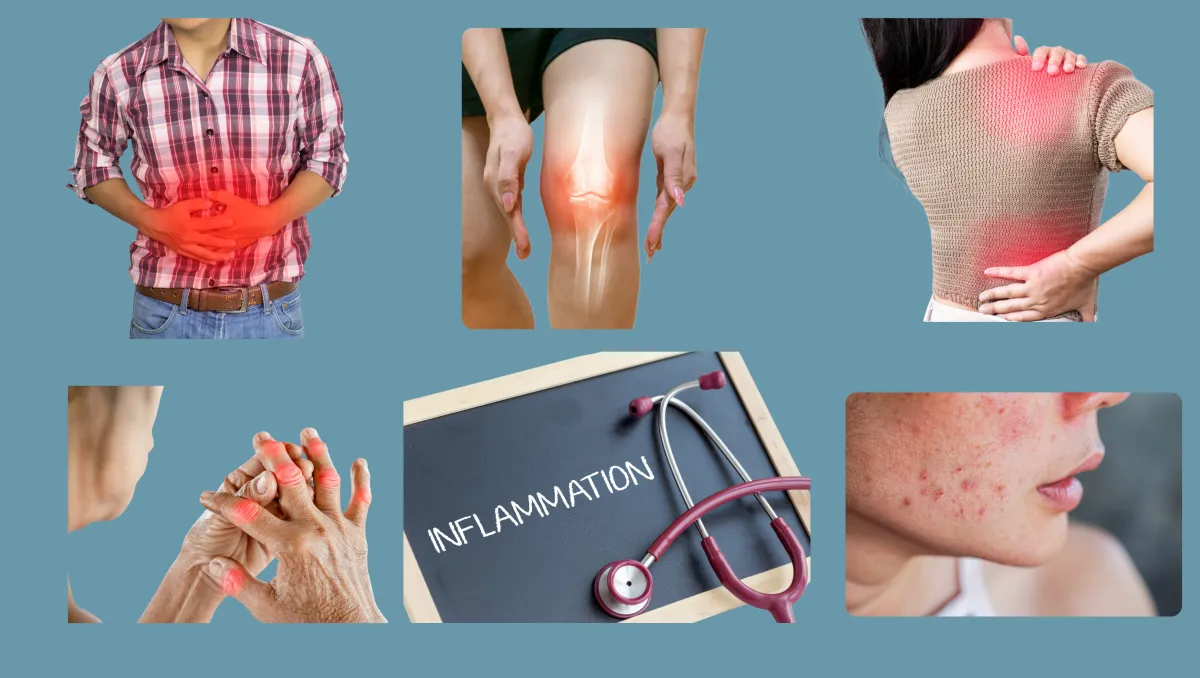
Is It Aging or Inflammation? How to Tell What’s Really Slowing You Down
You’re not imagining it: you feel slower, more tired, less sharp.
You chalk it up to aging. But what if it’s something else? Something you can actually change?
There’s a hidden culprit behind much of what we call “getting older.”
It’s inflammation. Not the dramatic kind from a twisted ankle: but low-grade, chronic, body-wide smoldering.
The kind that silently fuels fatigue, brain fog, joint pain, and weight gain.
Here’s the truth: aging and inflammation often look the same.
But if you spot the difference, you can change your trajectory.
A Tale of Two 50-Year-Olds
Take Susan and Mark. Both are in their early 50s.
Susan wakes up stiff, crashes mid-afternoon, and feels 70.
Mark bikes daily, sharp as ever, and sleeps like a rock.
Same age, different inflammation levels.
So what’s the difference?
One’s aging by the calendar. The other’s aging by inflammation.
What Is Inflammaging?
Scientists call it “inflammaging”: chronic inflammation that accelerates biological aging.
It’s not about fire and fever. It’s about a persistent whisper from your immune system that something’s wrong, even when there’s no clear threat.
And what fans the flames?
Poor diet, lack of sleep, stress, inactivity, and visceral fat—the deep belly fat that releases inflammatory compounds.
Spot the Signs: Is It Inflammation or Age?
Here’s how to tell:
Fatigue that lingers: If you sleep but still feel exhausted, that’s inflammation disrupting your mitochondria, your cell’s power plants.
Puffy joints or skin: Chronic low-grade inflammation can make your immune system overreact to everyday wear and tear.
Brain fog: Inflammatory molecules cross the blood-brain barrier, slowing your cognition.
Belly fat that resists change: Visceral fat isn’t just stored energy. It’s metabolically active, and inflammatory.
Elevated CRP or white blood cell count: Blood tests can show early signs of systemic inflammation even if you “feel fine.”
Here’s the Hope: Food Is Your Most Powerful Anti-Inflammatory Tool
Dr. Michael Greger, in How Not to Die, emphasizes that many inflammatory diseases are reversible with diet. A whole-food, plant-based approach doesn’t just stop the damage, it helps your body repair.

What to Do: Send Anti-Inflammatory Signals
You don’t need to overhaul your life. But your daily choices matter.
Eat colorful plants: Berries, greens, cruciferous veggies. The phytonutrients in plants fight oxidative stress and cool inflammation .
Cut ultra-processed foods: Especially meats and refined carbs, they spike inflammatory markers.
Move every day: Even 15 minutes of walking lowers inflammatory cytokines.
Sleep 7-8 hours: Your body detoxes inflammation while you rest.
Breathe and pause: Stress hormones like cortisol fuel inflammation. Mindful pauses help your system reset.
Mike’s Turnaround
Mike, 55, came in exhausted, achy, and moody.
His CRP was elevated, and he blamed “getting older.”
We focused on anti-inflammatory foods: leafy greens, beans, turmeric, and added 20 minutes of movement a day.
Within six weeks, he was sleeping better and had more energy than he’d felt in years.
He didn’t turn back time. He turned off the fire.
Reframe It: You’re Not Just Aging, You Might Be Inflamed
Not every symptom is “just age.”
Your cells are asking for help.
And your fork, feet, and sleep are the fastest way to answer.
Your Next Step: Try This Anti-Inflammatory Reset
Add one anti-inflammatory meal today: think lentils, kale, berries, and flax.
Walk 15 minutes after dinner.
Go screen-free 30 minutes before bed.
Then notice: How do you feel in a week?
Want to design your anti-inflammatory routine? Click here
References
1- Ridker, P. M., et al. (1997). "Inflammation, aspirin, and the risk of cardiovascular disease in apparently healthy men." New England Journal of Medicine, 336(14), 973-979. https://doi.org/10.1056/NEJM199704033361401
This study demonstrated how elevated levels of C-reactive protein (CRP), a key marker of inflammation, are predictive of heart disease risk .
2- Chung, H. Y., et al. (2009). "Molecular inflammation: underpinnings of aging and age-related diseases." Ageing Research Reviews, 8(1), 18-30. https://doi.org/10.1016/j.arr.2008.07.002
This review paper coined the term “inflammaging” and explains how chronic low-grade inflammation drives many aging-related diseases .
3- Greger, M. (2015). How Not to Die: Discover the Foods Scientifically Proven to Prevent and Reverse Disease. Flatiron Books. https://nutritionfacts.org/book/how-not-to-die/
4- Greger, M. (2019). How Not to Diet: The Groundbreaking Science of Healthy, Permanent Weight Loss. Flatiron Books. https://nutritionfacts.org/book/how-not-to-diet/

